Elisabeth Storrs's Blog
May 24, 2025
Garbo & the Swedish Queen – History Girls
My latest post in the History Girls blog is about Greta Garbo’s meteoric rise to stardom from a ‘lather girl’ in a barber shop to a screen goddess. She was keen to make a movie Queen Christina, about the controversial and scandalous C17th Swedish queen. MGM granted her wish but it was a very Hollywood take!
The post Garbo & the Swedish Queen – History Girls first appeared on Elisabeth Storrs Historical Novels.
May 19, 2025
On Inspiration: Napoleon’s Shadow Wife by James Conroyd Martin
 My guest today is James Conroyd Martin who returns to speak to me about his new book, Napoleon’s Shadow Wife. A Chicago native, James balanced his longtime teaching career with that of a novelist. He has retired from teaching to focus solely on writing. The diary of a friend’s ancestor, a Polish countess who lived in the late 1700s, inspired his first novel, Push Not the River. That led to a trilogy, as well as The Boy Who Wanted Wings, highlighting the saving of Vienna from the Ottomans at the Battle of Vienna in 1683. Following that came Fortune’s Child, the first of a duology based on sixth-century Empress Theodora, a woman the BBC rated as the 35th most important woman in World History. He also wrote a ghost story, Hologram: A Haunting, based on a house in Hammond, Indiana. Martin currently resides in Portland, Oregon.
My guest today is James Conroyd Martin who returns to speak to me about his new book, Napoleon’s Shadow Wife. A Chicago native, James balanced his longtime teaching career with that of a novelist. He has retired from teaching to focus solely on writing. The diary of a friend’s ancestor, a Polish countess who lived in the late 1700s, inspired his first novel, Push Not the River. That led to a trilogy, as well as The Boy Who Wanted Wings, highlighting the saving of Vienna from the Ottomans at the Battle of Vienna in 1683. Following that came Fortune’s Child, the first of a duology based on sixth-century Empress Theodora, a woman the BBC rated as the 35th most important woman in World History. He also wrote a ghost story, Hologram: A Haunting, based on a house in Hammond, Indiana. Martin currently resides in Portland, Oregon.
You can connect with James via his website, Facebook, Twitter and Instagram. You might be interested to read my interview with him about the inspiration for Fortune’s Child.
You can purchase Napoleon’s Shadow Wife here.
I asked James to tell us about the remarkable Marie Walewska, the faithful Polish mistress of Napoleon, and his inspiration for the novel.
A love born of politics, consumed by passion, and haunted by betrayal. Marie Walewska (nee Maria Łączyńska) was an incredible woman. At eight years old, she lost her father battling against Russia for Poland’s independence. The loss sowed the seeds of patriotism within her. Shortly after her schooling, in order to save the family estate, she was pressured into a marriage with a much older wealthy count, with whom she gave birth to a son. Marie herself arranged to meet Napoleon in a most unusual way—but not out of any romantic notion. Let’s leave that quest right there.
Marie Walewska (nee Maria Łączyńska) was an incredible woman. At eight years old, she lost her father battling against Russia for Poland’s independence. The loss sowed the seeds of patriotism within her. Shortly after her schooling, in order to save the family estate, she was pressured into a marriage with a much older wealthy count, with whom she gave birth to a son. Marie herself arranged to meet Napoleon in a most unusual way—but not out of any romantic notion. Let’s leave that quest right there.
I had heard people talk of Countess Marie Walewska, and I had seen the 1937 film Conquest with Greta Garbo as Marie and Charles Boyer as Napoleon. In researching the second book of my Poland trilogy, Against a Crimson Sky, which covered the Napoleonic years, I could not help but learn a great deal about her. It came as no surprise that Hollywood had invented a good deal of their screenplay.
But it was only in focusing on the woman as the main player in my novel that I came to feel I understood her. In fact, even after I had written the first draft, I was still unsure about having captured her essence. But as I went over the research again and followed through on one rewrite and then another, did I feel as if I came to really know her.
A story of patriotismMarie’s story is one of great patriotism. And it is one of an unconditional love that nearly defies understanding. She never intended to attract Napoleon, and yet she did. She had no wish to accept him as her lover, and yet she did. I think she surprised herself when—despite myriad complications—she fell hopelessly in love.
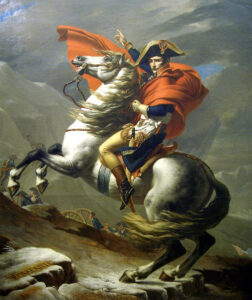 At the start of their affair, Napoleon was still married to Josephine, but he was disappointed that she had not given him a child. He had other affairs, too, but he repeated told Marie that her sincerity and unconditional love were what endeared her to him. That neither Josephine, nor any other woman, had given him the child he so desired, made the emperor think that the fault was his. It took Marie to ease his mind, presenting him with a baby boy.
At the start of their affair, Napoleon was still married to Josephine, but he was disappointed that she had not given him a child. He had other affairs, too, but he repeated told Marie that her sincerity and unconditional love were what endeared her to him. That neither Josephine, nor any other woman, had given him the child he so desired, made the emperor think that the fault was his. It took Marie to ease his mind, presenting him with a baby boy.
After a divorce from Josephine, Napoleon married again—but not to Marie. His obsession with creating a royal legacy led to a marriage with Archduchess Marie-Louise of Austria.
And yet, the connection between Marie and Napoleon continued. It would outlast even the second marriage.
Decide for yourselfDid Napoleon love Marie? Many of his actions seem to supply an abundance of evidence that he did not. However, I think that he did, but not in a conventional way—and certainly not in the unconditional way in which she loved him. As the author, I did not try to lead the reader; I placed the evidence on the page, and I suspect readers will judge for themselves.
How could an emperor like Napoleon Bonaparte be so captivated by the twenty-year-old Polish Countess Marie Walewska—admittedly a rare beauty but of minor nobility—that their affair would last through both his marriages? And if it wasn’t romance that first drew Marie to Napoleon, what was it?
Expect to be immersed in Marie’s world, where love and loyalty collide amidst a galaxy of powerful aristocrats, politicians, and military leaders. You’ll journey from Marie’s manor house on the plains of Poland to cosmopolitan Warsaw, through grand palaces in Austria, France, and Italy—before sailing to the Island of Elba, where destiny awaits.
Thanks James! I have heard about Josephine and Desiree but this was the first I’d learned of Marie. What an amazing young woman she must have been. Good luck with the book! And congratulations on your placing in the Goethe Award.
You can purchase Napoleon’s Shadow Wife here.

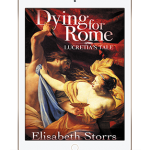 Haven’t subscribed yet to enter into giveaways from my guests? You’re not too late for the chance to win this month’s book if you subscribe to my Monthly Inspiration newsletter for giveaways and insights into history – both trivia and the serious stuff! In appreciation for subscribing, I’m offering an 80 page free short story Dying for Rome -Lucretia’s Tale.
Haven’t subscribed yet to enter into giveaways from my guests? You’re not too late for the chance to win this month’s book if you subscribe to my Monthly Inspiration newsletter for giveaways and insights into history – both trivia and the serious stuff! In appreciation for subscribing, I’m offering an 80 page free short story Dying for Rome -Lucretia’s Tale.
The post On Inspiration: Napoleon’s Shadow Wife by James Conroyd Martin first appeared on Elisabeth Storrs Historical Novels.
April 14, 2025
On Inspiration: Interview with Galina Vromen
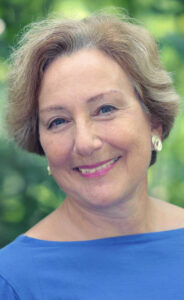 My guest this month is debut author, Galina Vromen, author of Hill of Secrets. Galina began writing fiction after more than twenty years as an international journalist in Israel, England, the Netherlands, France, and Mexico. After a career with Reuters News Agency, she moved into the nonprofit sector as a director at the Harold Grinspoon Foundation and headed their operations in Israel. There she launched and directed two reading readiness programs, one in Hebrew and one in Arabic, which gifted twenty million books to young children and their families during her tenure and were named US Library of Congress honorees for best practices in promoting literacy. She has an MA in literature and a BA in media and anthropology. She and her husband divide their time between Israel and Massachusetts where Galina loves to swim, hike, kayak, write, read and hang out with friends.
My guest this month is debut author, Galina Vromen, author of Hill of Secrets. Galina began writing fiction after more than twenty years as an international journalist in Israel, England, the Netherlands, France, and Mexico. After a career with Reuters News Agency, she moved into the nonprofit sector as a director at the Harold Grinspoon Foundation and headed their operations in Israel. There she launched and directed two reading readiness programs, one in Hebrew and one in Arabic, which gifted twenty million books to young children and their families during her tenure and were named US Library of Congress honorees for best practices in promoting literacy. She has an MA in literature and a BA in media and anthropology. She and her husband divide their time between Israel and Massachusetts where Galina loves to swim, hike, kayak, write, read and hang out with friends.
You can connect with Gallina via her website and Amazon author page. You can buy Hill of Secrets here.
What or who inspired you to first write? Which authors have influenced you?My grandfather first inspired me to write. I sent him a poem when I was about eight and he sent me one back, riffing off of my poem. I was a big reader as a kid and I always imagined that I would write. My fantasy was to be a journalist for National Geographic Magazine and I imagined marrying a photographer and traveling around the world as a team, writing and photographing interesting places. In terms of historical fiction, I would say the biggest influences have been Kate Quinn and Kelly Rimmer. In terms of books with changing points of view, Kathryn Stockett’s The Help was a model that I very much admire and used as a guide. In terms of beautifully evocative, sensual writing, Andre Aciman is an author who sets a high bar to aspire to.
What is the inspiration for Hill of Secrets? Is there a particular theme you wished to explore?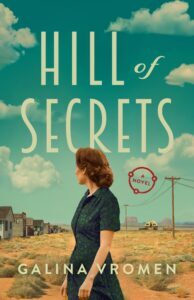 I very much wanted to explore the notion of secrets, the role they play in our personal and collective lives, and to raise the question of when is it best keep secrets and when is best to reveal them – and for whose sake? I chose WW2 Los Alamos as the location for my novel because it was arguably the most secret place in the US at the time (even though 6,000 people lived there!). And my main characters all have personal secrets, except for one (Gertie, a teen) who desperately wants to learn everyone else’s secrets.
I very much wanted to explore the notion of secrets, the role they play in our personal and collective lives, and to raise the question of when is it best keep secrets and when is best to reveal them – and for whose sake? I chose WW2 Los Alamos as the location for my novel because it was arguably the most secret place in the US at the time (even though 6,000 people lived there!). And my main characters all have personal secrets, except for one (Gertie, a teen) who desperately wants to learn everyone else’s secrets.
I like 20th century history in part because it is a century where so much happened and because so many events then still influences us today.
What resources do you use to research your book? How long did it take to finish the novel?I read a lot about Los Alamos and the Manhattan Project, including American Prometheus, the very detailed biography of Robert Oppenheimer which the film Oppenheimer was based on. There are lots of oral histories of people who lived at Los Alamos during WW2, including children, wives, maids, manual workers and those testimonies were very important in my research. In addition, quite a lot of people who lived at Los Almos during WW2 later wrote memoirs, so I read a lot of them. The book took me 12 years to write but I started reading about Los Alamos for about a decade before then.
What do you do if stuck for a word or a phrase?I use google to look for any kind of synonym for the word or phrase at the tip of my mind. Or – terrible habit – I go to the kitchen and eat something. Unfortunately, that doesn’t help me find the word I’m looking for, just means the more words I can’t find, the fatter I get.
Is there anything unusual or even quirky that you would like to share about your writing?I like to write in small, spare rooms. I wrote my undergraduate thesis in a walk-in closet to concentrate, and I like to write in study rooms in libraries, where I have no excuse to get distracted. Because I was a news reporter for many years, writing while several different radio and TV stations were going on at once, I also can write with a lot of noise around me.
Is there a particular photo or piece of art that strikes a chord with you? Why?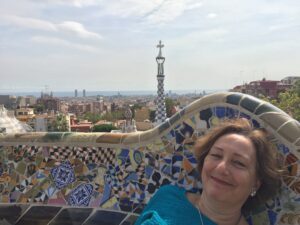 I was blown away by the mosaic work of Antoni Gaudi at the Guell Park in Barcelona. First of all, I love mosaics and love making mosaic work myself, so I was in heaven just being there. I love the riot of colors and how each small bit is part of a whole, how each piece both fits in and yet stands out at the same time. Mosaics just seem such a metaphor for so much in life, and it was just beautiful!
I was blown away by the mosaic work of Antoni Gaudi at the Guell Park in Barcelona. First of all, I love mosaics and love making mosaic work myself, so I was in heaven just being there. I love the riot of colors and how each small bit is part of a whole, how each piece both fits in and yet stands out at the same time. Mosaics just seem such a metaphor for so much in life, and it was just beautiful!
No, I haven’t used Scrivener though I would consider doing so in the future. I never write in long hand because I type very fast from years of being a reporter and I can riff with a keyboard and keep up with my thoughts much better by typing them than by writing long hand.
What advice would you give an aspiring author?Persistence is what it’s all about. You just have to keep at it. And don’t let the detractors, the nay sayers, get to you. I stopped writing for about three years because of something someone I trusted said about my work. I should have just ignored her. Another piece of advice: less is almost always more. Don’t use two adjectives when one will do, don’t overexplain to your reader. So often, writers (including me) feel a need to set a scene, give background before they jump into a chapter, when they could start a page or two down, and get into the action, without the preamble. And there is a tendency go on too long at the end of a chapter. So always look at those first few and last few paragraphs of a chapter and consider whether you really need them.
Tell us about your next book.I’m thinking of doing a sequel that would follow one of the characters in the book into the 1950s. The idea is not very formed yet.

When Robert Oppenheimer gathers a group of scientists at the clandestine desert outpost of Los Alamos to create the world’s first nuclear weapon, their families move there as well with no explanation other than to “Stand by. Make do. And above all, don’t ask questions.” In this immersive novel, the lives of real historical figures intertwine with fictional characters who must cope with suppressed yearning, irrepressible love and guilt. Among them are Christine Sharp, forced to abandon her art restoration business in New York to support her husband’s career and must re-invent herself. She forges an unlikely friendship with Gertie, the precocious teenage daughter of German-Jewish refugee and prominent physicist Kurt Koppel. Gertie enlists Christine to help her capture the heart of Jimmy, a shy soldier, and to deal with parents haunted by their past. Kurt, anguished by what the Nazis have done to his family and bent on defeating them, carries burdens he longs to share. In revealing the complexities of life for those at Los Alamos who knew about the bomb and those who couldn’t be told, HILL OF SECRETS explores the complicated web of secrets we all spin and hold as we navigate our way through life. And like Oppenheimer and his team, they all must contend with the moral questions and aftermath of creating the bomb that destroyed Hiroshima and Nagasaki.
Thanks Galina – the novel sounds complex and fascinating. I hope you figure out an angle for the sequel.
 Haven’t subscribed yet to enter into giveaways from my guests? You’re not too late for the chance to win this month’s book if you subscribe to my Inspiration newsletter and comment on the interview. In appreciation for subscribing, I’m offering an 80 page free short story Dying for Rome -Lucretia’s Tale.
Haven’t subscribed yet to enter into giveaways from my guests? You’re not too late for the chance to win this month’s book if you subscribe to my Inspiration newsletter and comment on the interview. In appreciation for subscribing, I’m offering an 80 page free short story Dying for Rome -Lucretia’s Tale.
The post On Inspiration: Interview with Galina Vromen first appeared on Elisabeth Storrs Historical Novels.
March 12, 2025
On Inspiration: Interview with Annie R McEwen
 My guest this month is Annie R McEwen, a career historian who has lived in six countries and under every roof from a canvas tent to a Georgian Era manor house. She is published by Harbor Lane Books (US), Bloodhound Books (UK), The Wild Rose Press, and Rowan Prose Publishing. When she’s not in her 1920s bungalow in Florida, Annie lives, writes, and explores castles in Wales. A winner of the 2022 Page Turners Writing Award (Romance Category), Annie garnered both a First and Second Place 2022 RTTA (Romance Through the Ages Award), the 2023 MAGGIE Award, and the 2023 Daphne du Maurier Award. She was a Finalist for the 2024 Page Turners Writing Award and Shortlisted for a Writer’s Mentorship Award. Annie’s short fiction appears in numerous anthologies.
My guest this month is Annie R McEwen, a career historian who has lived in six countries and under every roof from a canvas tent to a Georgian Era manor house. She is published by Harbor Lane Books (US), Bloodhound Books (UK), The Wild Rose Press, and Rowan Prose Publishing. When she’s not in her 1920s bungalow in Florida, Annie lives, writes, and explores castles in Wales. A winner of the 2022 Page Turners Writing Award (Romance Category), Annie garnered both a First and Second Place 2022 RTTA (Romance Through the Ages Award), the 2023 MAGGIE Award, and the 2023 Daphne du Maurier Award. She was a Finalist for the 2024 Page Turners Writing Award and Shortlisted for a Writer’s Mentorship Award. Annie’s short fiction appears in numerous anthologies.
You can connect with Annie via her website, Facebook, Instagram, Goodreads and Bluesky
Annie’s latest release is the The Corset Girls, Unlaced. You can find all Annie’s books on Amazon.
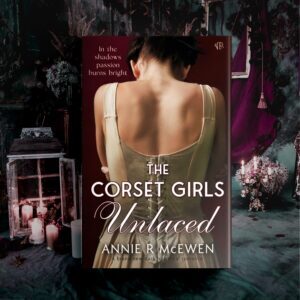 What or who inspired you to first write? Which authors have influenced you?
What or who inspired you to first write? Which authors have influenced you?As a teen I was mad for writers of the Romantic Age (early to late, British, French, and American): Charlotte Bronte, Charles Dickens, Elizabeth Barrett Browning, Edgar Allan Poe, Emile Zola. In more modern fiction, and as a genre fiction author, I have learned much from Diana Norman, Anne Perry, Dorothy Sayers, Daphne du Maurier, and the very clever Joanna Bourne.
What is the inspiration for your current book? Is there a particular theme you wished to explore?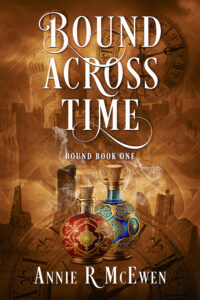 The Corset Girls, Unlaced, is what I call Victorian noir romance. To say I’m inspired by history is self-evident—I’m a career historian—but as a reader of historical romance, especially that of the Regency to Edwardian Eras, I saw a preponderance of themes attached to the upper class at play: wealth, society gossip, the ballroom, bared shoulders and well-cut tailcoats. I like to write the working classes, especially in Industrial Age Britain. Their passion is just as soaring, their quest for happiness just as profound. In The Corset Girls four-book series, the focus is on four working women (staymakers) and the four men (all from problematic and even criminal backgrounds) who love them. All eight are swept along in an age of technological marvels and social unrest. None of the eight appear in Burke’s Peerage, but a couple might be found in Newgate Prison!
The Corset Girls, Unlaced, is what I call Victorian noir romance. To say I’m inspired by history is self-evident—I’m a career historian—but as a reader of historical romance, especially that of the Regency to Edwardian Eras, I saw a preponderance of themes attached to the upper class at play: wealth, society gossip, the ballroom, bared shoulders and well-cut tailcoats. I like to write the working classes, especially in Industrial Age Britain. Their passion is just as soaring, their quest for happiness just as profound. In The Corset Girls four-book series, the focus is on four working women (staymakers) and the four men (all from problematic and even criminal backgrounds) who love them. All eight are swept along in an age of technological marvels and social unrest. None of the eight appear in Burke’s Peerage, but a couple might be found in Newgate Prison!
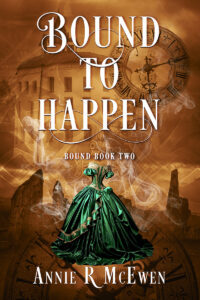 My deep love for and kinship with the Victorian and Edwardian Ages comes from three sources: one familial, one literary, one academic/professional. Familial: One of the most influential people in my childhood was my godmother, born in 1884. A near-invalid, she lived in a cottage surrounded by reminders of her genteel past, and told story after story of what it was like to be a child before automobiles and telephones. Literary: The books I most loved as a child were written in the 1800s. The first I wept over was Black Beauty. I learned what fantasy and adventure were from Jules Verne and H.G. Wells and Robert Louis Stevenson. Charles Dickens taught me about writing character, and how each individual is a metonym for the greater society of the time. Academic and Professional: At university, I was drawn to the vast changes in Western society from the 1840s to World War One; the material culture of that interval is my area of specialisation.
My deep love for and kinship with the Victorian and Edwardian Ages comes from three sources: one familial, one literary, one academic/professional. Familial: One of the most influential people in my childhood was my godmother, born in 1884. A near-invalid, she lived in a cottage surrounded by reminders of her genteel past, and told story after story of what it was like to be a child before automobiles and telephones. Literary: The books I most loved as a child were written in the 1800s. The first I wept over was Black Beauty. I learned what fantasy and adventure were from Jules Verne and H.G. Wells and Robert Louis Stevenson. Charles Dickens taught me about writing character, and how each individual is a metonym for the greater society of the time. Academic and Professional: At university, I was drawn to the vast changes in Western society from the 1840s to World War One; the material culture of that interval is my area of specialisation.
When I became a museum professional (more than 27 years in that work), I had the good fortune to be staff in two sites whose mission was the interpretation of that period (1886 and 1891, respectively), as well as the Executive Director of a historic (circa 1891) house museum. The decades presented at those sites offered the worst behaviours, the most grinding poverty, the most blatant inequality, and the deepest despair. At the same time, they offered a seemingly boundless world of science, ideas, the arts, and education. I find endless inspiration in that contrast.
What resources do you use to research your book? How long did it take to finish the novel?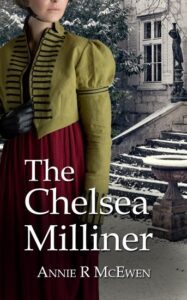 While the final manuscript of The Corset Girls, Unlaced coalesced over a year, I had already spent two years developing the series concept. To write the books, I rely on many years of prior research into Britain in the 1890s, refreshed—as always—by new scholarly work published every week. I’m a fan of the Internet only insofar as it’s the handiest and largest encyclopedia in the known world. It is flawed, however, and is more problematic since the intrusion of AI into search engines. I still use books, the digital or paper kind, and engage my academic habit of digging through scholarly journals (most of them digitised today.) A few online blogs or compendia of historical knowledge provide help: the Jane Austen Centre’s blog articles, for example, or Candace Hern’s excellent website. And The Historical Novel Society, of course.
While the final manuscript of The Corset Girls, Unlaced coalesced over a year, I had already spent two years developing the series concept. To write the books, I rely on many years of prior research into Britain in the 1890s, refreshed—as always—by new scholarly work published every week. I’m a fan of the Internet only insofar as it’s the handiest and largest encyclopedia in the known world. It is flawed, however, and is more problematic since the intrusion of AI into search engines. I still use books, the digital or paper kind, and engage my academic habit of digging through scholarly journals (most of them digitised today.) A few online blogs or compendia of historical knowledge provide help: the Jane Austen Centre’s blog articles, for example, or Candace Hern’s excellent website. And The Historical Novel Society, of course.
Walk away, have a cuppa, try again.
Is there anything unusual or even quirky that you would like to share about your writing?I usually retire early and wake at three in the morning. I then write steadily until around ten or eleven a.m.
Do you use a program like Scrivener to create your novel? Do you ever write in long hand?The first, no, never. The second, sometimes. I do some of my best writing in notebooks I keep in my car and scribble upon in coffeeshops. What I write that way undergoes a lot of revision in its journey to a typed manuscript, however.
Is there a particular photo or piece of art that strikes a chord with you? Why?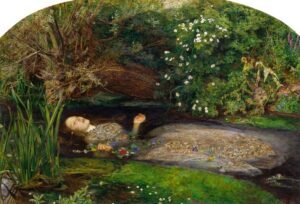 Like most people who first see famous art in a book, I fell in love as a teenager with Botticelli’s The Birth of Venus. As an adult, when I saw the actual painting in the Uffizi in Florence, I was struck by how small it is. It demonstrated that enduring art is not necessarily big. In my work, I don’t strive for big. I strive for compactly interesting, highly textured, and, if possible, beautiful. I also love Ophelia by John Everett Millais. (1851 Google Art Project).
Like most people who first see famous art in a book, I fell in love as a teenager with Botticelli’s The Birth of Venus. As an adult, when I saw the actual painting in the Uffizi in Florence, I was struck by how small it is. It demonstrated that enduring art is not necessarily big. In my work, I don’t strive for big. I strive for compactly interesting, highly textured, and, if possible, beautiful. I also love Ophelia by John Everett Millais. (1851 Google Art Project).
People will tell you, ‘Don’t stop.’ I say, ‘Don’t stop improving.’
Tell us about your next book.Boundless, the last of a trilogy of ghost romance novels (all with hefty historical content), launches later this year. Book Two of The Corset Girls (titled Unbound) sees the light in Summer 2025. Moonlight and Margaritas, launching in March 2025, is a romance anthology that includes my short story set in London just prior to WWII: a tale of spies, love, and cocktails.

After a desperate act leaves Jillian Morehouse a fugitive, she flees to Whitechapel. The escapee finds work in a Mayfair corset workshop, but the walls are closing in.
Jillian catches the eye of the handsome Michael Kelly, a reformed criminal with a dangerous history he’s anxious to keep hidden. The pair are drawn together by a powerful attraction—but their love is tested when she’s kidnapped and abandoned in the catacombs beneath London.
With enemies circling and secrets threatening to destroy them both, Jillian and Michael must confront their darkest fears . . . or lose everything to the shadows of their pasts.
Thanks Annie – all the best with The Corset Girls, Unlaced. I love the idea of Victorian noir!

Haven’t subscribed yet to enter into giveaways from my guests? You’re not too late for the chance to win this month’s book if you subscribe to my Inspiration newsletter and comment on the interview. In appreciation for subscribing, I’m offering an 80 page free short story Dying for Rome -Lucretia’s Tale.
The post On Inspiration: Interview with Annie R McEwen first appeared on Elisabeth Storrs Historical Novels.
January 21, 2025
On Inspiration: Interview with Melissa Addey
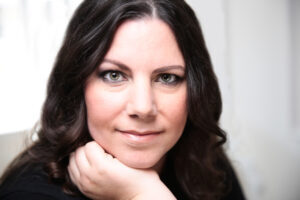 My guest today is fellow Romaphile, Melissa Addey. However, Melissa doesn’t just limit herself to the history of the Eternal City! She also writes historical fiction set in medieval Morocco, 18th century China and Regency England. Her books have been selected for Editor’s Choice by the Historical Novel Society and won the inaugural Novel London award. She has been the Leverhulme Trust Writer in Residence at the British Library and has a PhD in Creative Writing. She lives in London with her husband and two children.
My guest today is fellow Romaphile, Melissa Addey. However, Melissa doesn’t just limit herself to the history of the Eternal City! She also writes historical fiction set in medieval Morocco, 18th century China and Regency England. Her books have been selected for Editor’s Choice by the Historical Novel Society and won the inaugural Novel London award. She has been the Leverhulme Trust Writer in Residence at the British Library and has a PhD in Creative Writing. She lives in London with her husband and two children.
If you’d like to try Melissa’s writing, visit www.melissaaddey.com to pick up two free novellas, The Cup and The Consorts. You can connect with Melissa via Instagram and TikTok.
You can buy Melissa’s (many) books via her Amazon page.
What or who inspired you to first write? Which authors have influenced you? I read an enormous amount as a child (we didn’t have a TV!) – all the classics as well as a lot of myths and legends from around the world, which I loved. I think reading all of those eventually came back out again in my own stories. In historical fiction, Tracy Chevalier who finds fascinating and unusual topics to write about, Philippa Gregory for her Tudor and Plantagenet series, where each book takes a different viewpoint, forcing you to revisit events from a new perspective, it’s something I’ve done in two of my series and I both love reading them and writing in that way – sitting down to write the ‘bad’ person’s viewpoint is a real workout as a writer. I love reading John Steinbeck, Terry Pratchett and Stephen King, so I can only hope something of their skills eventually rubs off on me!
I read an enormous amount as a child (we didn’t have a TV!) – all the classics as well as a lot of myths and legends from around the world, which I loved. I think reading all of those eventually came back out again in my own stories. In historical fiction, Tracy Chevalier who finds fascinating and unusual topics to write about, Philippa Gregory for her Tudor and Plantagenet series, where each book takes a different viewpoint, forcing you to revisit events from a new perspective, it’s something I’ve done in two of my series and I both love reading them and writing in that way – sitting down to write the ‘bad’ person’s viewpoint is a real workout as a writer. I love reading John Steinbeck, Terry Pratchett and Stephen King, so I can only hope something of their skills eventually rubs off on me!
I’m writing a standalone Regency romance series called the Regency Outsiders – it follows the Regency romance subgenre, but tries to explore what it might be like to be a little outside the ‘norms’ of that society – from people declared ‘lunatics’ to those who are neurodivergent or disabled, those who have been locked into engagements from childhood and expected to go through with them. I’m enjoying mixing beloved tropes of the subgenre with characters who do not always fit the expected behaviour of those tropes. Right now the book I’m completing, The Viscount’s Pearl, has a woman who is probably autistic, which I found interesting as it runs in my family and I thought that a section of society that has very demanding social expectations would be tricky for someone neurodivergent to navigate.
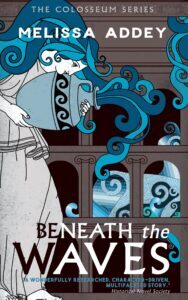 Just before starting this series I worked on a series of four books set in Ancient Rome, because I was curious – if the Colosseum had such vast spectacles, who was organising them? A similar size arena today has 3000 members of staff – yet there is zero mention of the backstage team of the Colosseum, so I had a lot of fun recreating them from the evidence left behind. For example, someone must have found, trapped and trained animals. There is mention of coloured sand in the arena – so someone must dye it and if you have different colours of sand, what are you using it for? Presumably to make patterns, perhaps to dance through (there were dancing girls in the breaks) or to indicate parts of the scenery. All those myths and legends I read came in handy for this series because they used to re-enact a lot of them with gladiators or unfortunate prisoners.
Just before starting this series I worked on a series of four books set in Ancient Rome, because I was curious – if the Colosseum had such vast spectacles, who was organising them? A similar size arena today has 3000 members of staff – yet there is zero mention of the backstage team of the Colosseum, so I had a lot of fun recreating them from the evidence left behind. For example, someone must have found, trapped and trained animals. There is mention of coloured sand in the arena – so someone must dye it and if you have different colours of sand, what are you using it for? Presumably to make patterns, perhaps to dance through (there were dancing girls in the breaks) or to indicate parts of the scenery. All those myths and legends I read came in handy for this series because they used to re-enact a lot of them with gladiators or unfortunate prisoners.
This is a guest post Melissa wrote for A Writer of History about doing the research for those books.
What period of history particularly inspires or interests you? Why?It’s not very commercially savvy of me to keep moving from era to era, but I’ve come to see myself as a sort of wandering minstrel: I go to an era that fascinates me, find the stories I want to share, then move onwards. I hope my readers enjoy travelling alongside me. So far I’ve visited Ancient Rome, medieval Morocco, 18th century China and right now I’m working on Regency England. My Roman Colosseum series consisted of 4 books, From the Ashes, Beneath the Waves, On Bloodied Ground and A Flight of Birds. They followed the backstage team of the Colosseum – a retired centurion, his scribe, an ex-Vestal Virgin, a runaway slave boy and a She Wolf (prostitute) as well as other found family, as they escape Pompeii as it gets destroyed and then inaugurate the Colosseum. Each book follows one element – fire, water, earth and air. I loved following their lives as the Colosseum grew and changed.
What resources do you use to research your book? How long did it take to finish the novel?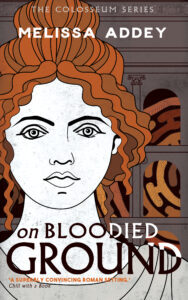 I usually collect books for a while, then start looking for articles or specific pieces of info I need to fill gaps required by the plot. Then I’ll go through a phase of sensory research: cooking recipes from the period, watch dances, go on research trips (my most recent was to London’s oldest perfume shop, which was amazing!) maybe even dress up. I use Pinterest to gather lots and lots of images that bring the book to life for me visually – including the fun of clothes for my heroines especially – I can spend a whole morning picking bonnets and frocks! I listen to music from the era or something suitably evocative while writing. For my Roman books the fantastic Steve Cockings, an international re-enactor, invited me twice to his house for the most wonderful Saturnalia feasts just before Christmas – he cooks food from the period and serves it on real or replica tableware. Everyone dresses up. He dressed me in a Roman lady’s outfit and then put real 1st century jewellery on me and I was sipping from real 1st century cups… it’s an awe-inspiring feeling.
I usually collect books for a while, then start looking for articles or specific pieces of info I need to fill gaps required by the plot. Then I’ll go through a phase of sensory research: cooking recipes from the period, watch dances, go on research trips (my most recent was to London’s oldest perfume shop, which was amazing!) maybe even dress up. I use Pinterest to gather lots and lots of images that bring the book to life for me visually – including the fun of clothes for my heroines especially – I can spend a whole morning picking bonnets and frocks! I listen to music from the era or something suitably evocative while writing. For my Roman books the fantastic Steve Cockings, an international re-enactor, invited me twice to his house for the most wonderful Saturnalia feasts just before Christmas – he cooks food from the period and serves it on real or replica tableware. Everyone dresses up. He dressed me in a Roman lady’s outfit and then put real 1st century jewellery on me and I was sipping from real 1st century cups… it’s an awe-inspiring feeling.
A book takes approximately 6 months from beginning to publication, the first in a new era is always a little slower but once I’m embedded in an era it gets a little faster.
What do you do if stuck for a word or a phrase?The thesaurus is often my good friend, but I also have things like lists of names, slang, cookery books, etc. for each era, and those are very helpful in filling in important details. I have a great book on Regency food, so I have fun devising fancy meals every time my characters need to eat. The Roman plebians ate more simply as many didn’t even have kitchens, but knowing how much Romans today love their food I created a street food owner who is the best friend of my main narrator, so that I could talk about all the delicious things she cooks from simple ingredients.
Is there anything unusual or even quirky that you would like to share about your writing?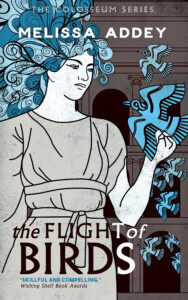 I think I’ve found I love to write about very tight social situations where putting a foot wrong leads to anything from social ostracism to death, and then working out how my characters will cope with not fitting those expectations. I like both the rules and what happens when they are broken or at least challenged. And I love sensory research! I think it makes the era come alive for me and therefore for the reader as well.
I think I’ve found I love to write about very tight social situations where putting a foot wrong leads to anything from social ostracism to death, and then working out how my characters will cope with not fitting those expectations. I like both the rules and what happens when they are broken or at least challenged. And I love sensory research! I think it makes the era come alive for me and therefore for the reader as well.
No, just Word for me. I scribble a lot of lists of things to do or ideas for plots etc., but they go into the computer pretty fast.
What advice would you give an aspiring author?Read a lot. Write as often and as much as you can because your writing will get better with practising, even if you don’t realise it.
Is there a particular photo or piece of art that strikes a chord with you? Why? It’s a photo from Unsplash but I no longer have the photographer details – when I saw this it perfectly summed up the feeling of my book The Cold Palace, which focuses on an empress of China who ‘went mad’ and her life in the Forbidden City. I love it and I use it in my book trailers for that series all the time.
It’s a photo from Unsplash but I no longer have the photographer details – when I saw this it perfectly summed up the feeling of my book The Cold Palace, which focuses on an empress of China who ‘went mad’ and her life in the Forbidden City. I love it and I use it in my book trailers for that series all the time.
I’ve just finished and will be editing The Viscount’s Pearl, with the autistic heroine. After that I’m moving on to write To Win Her Hand which will be a Christmas Regency romance. It’s based on a line from Pride and Prejudice where Lady Catherine de Burgh says that Mr Darcy and her daughter were intended to marry since they were in the cradle. I wanted to explore what that would feel like – being duty bound to marry someone you barely know. I read years ago that every author should have a Christmas book in their back catalogue and having just checked Amazon’s Top 100 mid December and found 20+ Christmas titles, so it looks like they might be right. So this is my one! I’m lucky that the Regency era I’m using included not just lovely Christmas traditions but also 1814 had the last Frost Fair where the River Thames in London froze over and there was a huge celebration on it with thousands of people, fires, foods, music and dancing – so I have not just Christmas but a bonus Frost Fair to use in my story!
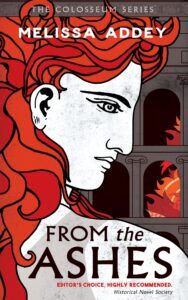
They called it the Flavian Amphitheatre. We call it the Colosseum. Let the Games begin.
Rome, 80AD. A gigantic new amphitheatre is being built. The Emperor has plans for gladiatorial Games on a scale no-one has ever seen before. But the Games don’t just happen by themselves. They must be made. And Marcus, the man in charge of creating them, has just lost everything he held dear when Pompeii disappeared under the searing wrath of Vesuvius.
Now it will fall to Althea, the slave woman who serves as his scribe, to ensure the Colosseum is inaugurated on time – and that Marcus makes his way out of the darkness that calls to him.
Can a motley crew comprising a retired centurion, slaves, a prostitute and an ex Vestal Virgin pull off the greatest gladiatorial Games ever seen? Or will they fail and find themselves in the arena as punishment? Time is running out to deliver an unforgettable spectacle.
FROM THE ASHES is the first, fast-paced novel in the gripping new Colosseum series. Follow the quick-witted and fiercely loyal backstage team of the Colosseum through the devastation of Pompeii, plague and fire. This is historical fiction at its most captivating: both action-packed and tender.
Thanks so much for providing insights into your books, Melissa! I think it’s fantastic how you’ve delved into so many different eras and cultures. Good luck with your Regency series.
You can buy Melissa’s (many) books via her Amazon page.
 Haven’t subscribed yet to enter into giveaways from my guests? You’re not too late for the chance to win this month’s book if you subscribe to my Inspiration newsletter and comment on the interview. In appreciation for subscribing, I’m offering an 80 page free short story Dying for Rome -Lucretia’s Tale.
Haven’t subscribed yet to enter into giveaways from my guests? You’re not too late for the chance to win this month’s book if you subscribe to my Inspiration newsletter and comment on the interview. In appreciation for subscribing, I’m offering an 80 page free short story Dying for Rome -Lucretia’s Tale.
The post On Inspiration: Interview with Melissa Addey first appeared on Elisabeth Storrs Historical Novels.
November 24, 2024
On Inspiration: Interview with Samantha Greene Woodruff
 My guest today is Samantha Greene Woodruff who is the author of two #1 Amazon bestselling historical fiction novels, The Lobotomist’s Wife and The Trade Off. Sam has a BA in history from Wesleyan University and an MBA from the NYU Stern School of Business. She spent fifteen years at Viacom’s Nickelodeon before leaving to parent her two young children. After studying in the continuing education program at the Writing Institute at Sarah Lawrence College, Woodruff completed her first novel, The Lobotomist’s Wife, which was an Amazon First Reads pick. Her writing has appeared in Newsweek, Writer’s Digest, Female First, Read 650 and more. In addition, she has contributed an essay entitled “Jew-ish” about her lifelong conflicted relationship with Judaism, to the USA Today bestselling anthology, On Being Jewish Now (2024) edited by Zibby Owens. All proceeds from the book go to Artists Against Antisemitism, a non-profit founded in the aftermath of the October 7 attacks in Israel. Woodruff lives in southern Connecticut with her husband, two children, two dogs and a small reptile zoo.
My guest today is Samantha Greene Woodruff who is the author of two #1 Amazon bestselling historical fiction novels, The Lobotomist’s Wife and The Trade Off. Sam has a BA in history from Wesleyan University and an MBA from the NYU Stern School of Business. She spent fifteen years at Viacom’s Nickelodeon before leaving to parent her two young children. After studying in the continuing education program at the Writing Institute at Sarah Lawrence College, Woodruff completed her first novel, The Lobotomist’s Wife, which was an Amazon First Reads pick. Her writing has appeared in Newsweek, Writer’s Digest, Female First, Read 650 and more. In addition, she has contributed an essay entitled “Jew-ish” about her lifelong conflicted relationship with Judaism, to the USA Today bestselling anthology, On Being Jewish Now (2024) edited by Zibby Owens. All proceeds from the book go to Artists Against Antisemitism, a non-profit founded in the aftermath of the October 7 attacks in Israel. Woodruff lives in southern Connecticut with her husband, two children, two dogs and a small reptile zoo.
You can connect with Samantha via her website, Instagram, Facebook and Threads.
You can follow Samantha and buy her books on Amazon.
What or who inspired you to first write?I’m not sure there was one person or book that inspired me to start writing. I always loved to write, but it was a very personal outlet – I used creative writing more like journaling. Professionally I wrote tons of strategy presentations and reports analysing things like TV ratings (I worked on the business side at Nickelodeon.) The first time I tried to write a novel in earnest was in 2015 when I took a beginning novel writing continuing education class at Sarah Lawrence College. I discovered that I loved writing fiction and that writing a novel was a specific skill I wanted to hone. Fun fact: Annabel Monaghan was my first writing teacher.
Which authors have influenced you?As far as influence, like most writers, I’m a reader, so I think I’ve taken a little from many books I’ve read in my life. I’ve long loved historical fiction so, when I decided to start off in that genre, I looked to some of the contemporary greats like Beatriz Williams, Kristen Hannah, Kate Quinn, Martha Hall Kelly. They all do such a terrific job of putting the reader in the time and place in which their books are set and keeping the pages turning with compelling characters and story.
What is the inspiration for your current book? Is there a particular theme you wished to explore?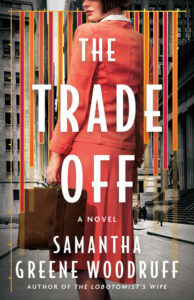 My inspiration for The Trade Off came from a 2021 event in the stock market, the GameStop “short squeeze.” GameStop was a business in decline and one prominent hedge fund manager was short the stock, when the price started to soar, costing the hedge funder a fortune. It grabbed headlines because the people who drove up the price were a group of amateur investors—mostly day traders who were home because of the pandemic—who banded together to “stick it” to what they perceived to be “evil” hedge funder. It was dramatic and personal, the hedge fund investor was reviled on social media and even received death threats.
My inspiration for The Trade Off came from a 2021 event in the stock market, the GameStop “short squeeze.” GameStop was a business in decline and one prominent hedge fund manager was short the stock, when the price started to soar, costing the hedge funder a fortune. It grabbed headlines because the people who drove up the price were a group of amateur investors—mostly day traders who were home because of the pandemic—who banded together to “stick it” to what they perceived to be “evil” hedge funder. It was dramatic and personal, the hedge fund investor was reviled on social media and even received death threats.
The stock market had never interested me before, even though I have an MBA and am married to an investor, but the human piece of the GameStop story piqued my interest. I think there is this assumption that most of the very rich, especially in finance, are evil and greedy while the poor are good. But is it accurate to tie make moral and ethical judgements of a person to their wealth? Nothing is ever that black and white. I wanted to wade into the grey area.
What period of history particularly inspires or interests you? Why?I am relatively time-period agnostic. I go to the period that makes sense for my story, or perhaps, the era I which an interesting person who I want to write about lived. Right now, I’m working on a dual-timeline book where the “historical” period is in Romania in the 1980s. The one thing that I know is that I tend to avoid WWII, so many authors do such a wonderful job writing about numerous aspects of this time in history, but it isn’t one that I want to tackle.
What resources do you use to research your book? How long did it take to finish the novel?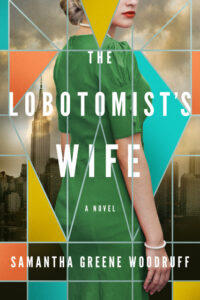 I start with articles I find on the internet and then go to books. For The Trade Off, there were a wealth of sources about the stock market crash of ’29, the roaring ‘20s, the Jewish immigrant experience on the Lower East Side of Manhattan and Wall Street in the early 20th century. Unfortunately, the same was not true of women on Wall Street in that era. I found a total of three books on the subject and a few articles that were excerpts from the same books. Ultimately, I connected with the author of one of these and interviewed him several times. I also chatted with archivists at the NASDAQ and J.P. Morgan Chase. I wrote the first draft for The Trade Off in eight months. Then I had two intense editing periods, one for six weeks and the other for three. I sold this book on proposal, so the timeline was tight!
I start with articles I find on the internet and then go to books. For The Trade Off, there were a wealth of sources about the stock market crash of ’29, the roaring ‘20s, the Jewish immigrant experience on the Lower East Side of Manhattan and Wall Street in the early 20th century. Unfortunately, the same was not true of women on Wall Street in that era. I found a total of three books on the subject and a few articles that were excerpts from the same books. Ultimately, I connected with the author of one of these and interviewed him several times. I also chatted with archivists at the NASDAQ and J.P. Morgan Chase. I wrote the first draft for The Trade Off in eight months. Then I had two intense editing periods, one for six weeks and the other for three. I sold this book on proposal, so the timeline was tight!
I put the idea I want to communicate in square brackets and move on. I know I will find a better way to say it when I go back later.
Do you use a program like Scrivener to create your novel? Do you ever write in long hand?I wrote my first two novels in Word. But when I finished my drafts, I made a PowerPoint presentation that was essentially index cards summarizing each chapter, which I then used to move things around as I edited. For the novel I’m working on now, I’m attempting to use Scrivener. I’m fairly certain that I am using about 1% of its capacity but just being able to slide a whole scene to a new spot feels like a win for me.
Is there a particular photo or piece of art that strikes a chord with you? Why?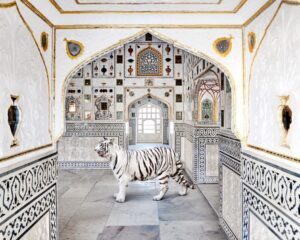 I was recently introduced to the photography of Karen Knorr and it is just spectacular. She has this series of animals in ornate, exotic settings that I could just marvel at for hours.
I was recently introduced to the photography of Karen Knorr and it is just spectacular. She has this series of animals in ornate, exotic settings that I could just marvel at for hours.
Becoming a published author takes strength and perseverance. You must be continually self-motivated and believe in yourself even when you feel like a fraud and a failure. Unfortunately, publishing is a business, and these days most authors have to do a lot of hustling to sell books. You are an entrepreneur establishing a new product: you and your writing. So, yes, you need to sit down and write; and, yes, you need to have the stamina to keep coming back to the page day after day, but you also must be willing to market yourself, to network and make connections, to participate in the author world. The good news is that, in my experience, authors are some of the most wonderful and supportive people I’ve ever come across. Oh, and find your writing “tribe.” This is a vulnerable career, and it is so important to have a person, or people, who are in it too and can be there for you in the high moments and the low ones. If you don’t know other aspiring writers, workshop groups or classes are a great way to meet them
Tell us about your next book.I am working on two ideas at parallel right now.
The first, which I mentioned briefly above, is a dual timeline story that takes place in New York City in essentially the present day and communist Romania in the 1980s. It is about a woman who discovers that she was a Romanian orphan adopted right after the collapse of communism in 1989, who goes on a journey to find out the truth about her past. And, the story of her mother, a true believer in communist propaganda in Romania in the last years of the Ceausescu rule, who comes to see the truth about the evil dictators, with painful consequences.
The second is a new genre for me: contemporary social satire/suspense. One year after making the move from Manhattan to one of the tiniest towns in the world, Greenwich, CT, a 30-something young mother thinks she’s finally figure out how to navigate in a world where everything is a competition. She has a a small group of true friends, a ridiculous waterfront home (thanks to her husband’s entrepreneurial success) and a happy three-year-old daughter in the best preschool around. But as she struggles to conceive her second child, odd, taunting things start happening: overly-personal gifts arrive on her doorstep, anonymous emails about her darkest struggles start to populate her in-box, her most sentimental keepsakes begin to disappear from her house. Suddenly, she wonders if her new friends and this town are really as perfect as they seem, or if this move has become the greatest threat to the future she always dreamed of.

A brilliant and ambitious young woman strives to find her place amid the promise and tumult of 1920s Wall Street in a captivating historical novel by the author of The Lobotomist’s Wife.
Bea Abramovitz has a gift for math and numbers. With her father, she studies the burgeoning Wall Street market’s stocks and patterns in the financial pages. After college she’s determined to parlay her talent for the prediction game into personal and professional success. But in the 1920s, in a Lower East Side tenement, opportunities for women don’t just come knocking. Bea will have to create them.
It’s easier for her golden-boy twin brother, Jake, who longs to reclaim all their parents lost after fleeing the pogroms in Russia to come to America. Well intentioned but undisciplined, Jake has a charm that can carry him only so far on Wall Street. So Bea devises a plan. They’ll be a secret team, and she’ll be the brains behind the broker. As Jake’s reputation, his heedless ego, and the family fortune soar, Bea foresees catastrophe: an impending crash that could destroy everything if she doesn’t finally take control.
Inspired by the true story of a pioneering investment legend, The Trade Off is a powerful novel about identity, sacrifice, family loyalties, and the complex morality of money.
Thanks Samantha – what a terrific storyline for a book! Thanks for sharing your inspiration and insights.
You can buy The Trade Off here.
 Haven’t subscribed yet to enter into giveaways from my guests? You’re not too late for the chance to win this month’s book if you subscribe to my Inspiration newsletter and comment on the interview. In appreciation for subscribing, I’m offering an 80 page free short story Dying for Rome -Lucretia’s Tale.
Haven’t subscribed yet to enter into giveaways from my guests? You’re not too late for the chance to win this month’s book if you subscribe to my Inspiration newsletter and comment on the interview. In appreciation for subscribing, I’m offering an 80 page free short story Dying for Rome -Lucretia’s Tale.
The post On Inspiration: Interview with Samantha Greene Woodruff first appeared on Elisabeth Storrs Historical Novels.
November 21, 2024
Cornelia Africana – My latest post on The History Girls
In my post on The History Girls I tell the story of the impressive Cornelia Africana – epitome of the Roman Matron yet she was far more than just the mother of The Gracchi Brothers and daughter of Scipio Africanus as described on her commemorative statue. Read more
The post Cornelia Africana – My latest post on The History Girls first appeared on Elisabeth Storrs Historical Novels.
October 25, 2024
On Inspiration: Interview with Aimie K Runyan
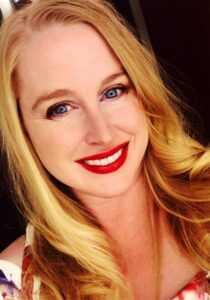 My guest today is Aimie K Runyan who writes fiction, both historical and contemporary, that celebrates the spirit of strong women. In addition to her writing, she is active as a speaker and educator in the writing community. She lives in Colorado with her amazing husband, kids, cats, and pet dragon. She has been honored as a Historical Novel Society Editors’ Choice selection, as a three-time finalist for the Colorado Book Awards, and as a nominee for the Rocky Mountain Fiction Writer of the Year. Her previous historical novels include The School for German Brides, Daughters of the Night Sky and A Bakery in Paris.
My guest today is Aimie K Runyan who writes fiction, both historical and contemporary, that celebrates the spirit of strong women. In addition to her writing, she is active as a speaker and educator in the writing community. She lives in Colorado with her amazing husband, kids, cats, and pet dragon. She has been honored as a Historical Novel Society Editors’ Choice selection, as a three-time finalist for the Colorado Book Awards, and as a nominee for the Rocky Mountain Fiction Writer of the Year. Her previous historical novels include The School for German Brides, Daughters of the Night Sky and A Bakery in Paris.
To learn more about Aimie, please visit her website.
You can find all Aimie’s books on her Amazon page. You can buy Mademoiselle Eiffel here.
What or who inspired you to first write? Which authors have influenced you?I was assigned to write a short story in third grade, and I thought it was the coolest thing ever. I’d loved reading and stories, and getting permission to tell my own was heady stuff. I was then cast as Scribbler Mouse in the school play later that year, and the rest is history!
What is the inspiration for your current book? Is there a particular theme you wished to explore?I wanted to write a book set in the Belle Epoque as a sort of follow on to A Bakery in Paris. I came across Claire Eiffel’s story—or at least a few snippets about her—and I was riveted. I really wanted to explore the themes of feminine duty and sacrifice.
What period of history particularly inspires or interests you? Why?I love any period of great upheaval or growth. Post war periods, periods of rebirth. That’s why A Bakery in Paris and then Mademoiselle Eiffel were so much fun to write.
What resources do you use to research your book? How long did it take to finish the novel?I used a large number of scholarly works, of course, as well as some on the ground research in Paris and quite a long dive into the archives at the Musée d’Orsay. It was so much fun to research!
Is there a particular photo or piece of art that strikes a chord with you? Why?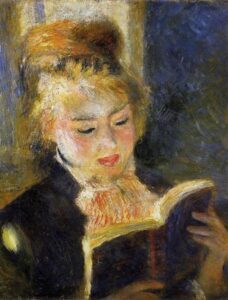 For years I loved Renoir’s “Woman Reading”. It seems on its surface to be a rather nice impressionist tableau of a woman with strawberry blonde hair dressed in black and reading a book. When one learns that Renoir preferred women who couldn’t read because they had sweeter tempers, and I’m rather glad she gets to defy the very man who painted her for as long as the painting exists.
For years I loved Renoir’s “Woman Reading”. It seems on its surface to be a rather nice impressionist tableau of a woman with strawberry blonde hair dressed in black and reading a book. When one learns that Renoir preferred women who couldn’t read because they had sweeter tempers, and I’m rather glad she gets to defy the very man who painted her for as long as the painting exists.
I’ll put whatever bland word I can think of and go back. Writing is re-writing and I’m not afraid to go back and do some polishing.
Is there anything unusual or even quirky that you would like to share about your writing?I do love writing in my recliner. And I generally prefer to write when there’s no one in the house. Solitude helps a lot.
Do you use a program like Scrivener to create your novel? Do you ever write in long hand?I do use Scrivener, and I love it. I think in scenes, so it’s very intuitive in many respects. I write in longhand when I am stuck and occasionally for “morning pages”. Fountain pens are a thing of beauty and a joy forever.
What advice would you give an aspiring author?Stop aspiring, start writing. Make like-minded writer friends who will give you honest feedback, and work on developing a thick skin. Your toolbox will require discipline, a solid group of writer pals, and a whole truckload of resiliency if you’re going to make it in the crazy business.
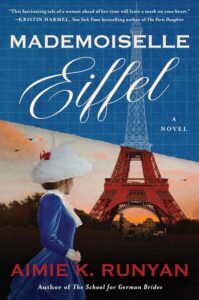
From the author of The School for German Brides and A Bakery in Paris, this captivating historical novel set in nineteenth-century Paris tells the story of Claire Eiffel, a woman who played a significant role in maintaining her family’s legacy and their iconic contributions to the city of Paris.
Claire Eiffel, the beautiful, brilliant eldest daughter of the illustrious architect Gustave Eiffel, is doted upon with an education envied by many sons of the upper classes, and entirely out of the reach of most daughters. Claire’s idyllic childhood ends abruptly when, at fourteen, her mother passes away. It’s soon made clear that Gustave expects Claire to fill her mother’s place as caregiver to the younger children and as manager of their home.
As she proves her competence, Claire’s importance to her father grows. She accompanies him on his travels and becomes his confidante and private secretary. She learns her father’s architectural trade and becomes indispensable to his work. But when his bright young protégé, Adolphe Salles, takes up more of Gustave’s time, Claire resents being pushed aside.
Slowly, the animosity between Claire and Adolphe turns to friendship…and then to something more. After their marriage in 1885 preserves the Eiffel legacy, they are privileged by the biggest commission of Eiffel’s career: a great iron tower dominating the 1889 World’s Fair to demonstrate the leading role of Paris in the world of art and architecture. Now hostess to the scientific elite, such as Thomas Edison, Claire is under the watchful eye not only of her family and father’s circle, but also the world.
When Gustave Eiffel’s involvement in a disastrous endeavor to build a canal in Panama ends in his imprisonment, it is up to Claire to secure her father’s freedom but also preserve the hard-won family legacy.
Claire Eiffel’s story of love, devotion, and the frantic pursuit to preserve her family’s legacy is not only an inspired reflection of real personages and historical events, but a hymn to the iconic tower that dominates the City of Lights.
Thanks so much, Aimie. What an incredible story of the woman behind the most famous iconic landmark!
 Haven’t subscribed yet to enter into giveaways from my guests? You’re not too late for the chance to win this month’s book if you subscribe to my Inspiration newsletter for giveaways and insights into history – both trivia and the serious stuff! In appreciation for subscribing, I’m offering an 80 page free short story Dying for Rome -Lucretia’s Tale.
Haven’t subscribed yet to enter into giveaways from my guests? You’re not too late for the chance to win this month’s book if you subscribe to my Inspiration newsletter for giveaways and insights into history – both trivia and the serious stuff! In appreciation for subscribing, I’m offering an 80 page free short story Dying for Rome -Lucretia’s Tale.
The post On Inspiration: Interview with Aimie K Runyan first appeared on Elisabeth Storrs Historical Novels.
September 23, 2024
On Inspiration: Interview with Crystal King
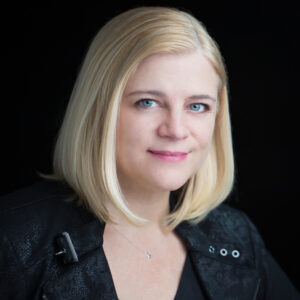 I’m delighted Crystal King has joined me again to share her journey in writing her latest novel, In The Garden of Monsters, a retelling of the Hades and Persephone myth, told from the point of view of a model Salvador Dali brings to Italy’s Sacro Bosco garden in 1948. She is also the author of The Chef’s Secret and Feast of Sorrow, which was long-listed at the Center for Fiction’s First Novel Prize and designated as a MassBook Awards Must Read. Crystal’s writing is fueled by a love of history and a passion for the food, language, and culture of Italy.
I’m delighted Crystal King has joined me again to share her journey in writing her latest novel, In The Garden of Monsters, a retelling of the Hades and Persephone myth, told from the point of view of a model Salvador Dali brings to Italy’s Sacro Bosco garden in 1948. She is also the author of The Chef’s Secret and Feast of Sorrow, which was long-listed at the Center for Fiction’s First Novel Prize and designated as a MassBook Awards Must Read. Crystal’s writing is fueled by a love of history and a passion for the food, language, and culture of Italy.
You can connect with Crystal via her website, Instagram, Threads @crystallin14, Substack, Youtube and Facebook. Follow her at Bookbub, Goodreads and Amazon.
You can purchase all Crystal’s books here.
What is the inspiration for In the Garden of Monsters? Is there a particular theme you wished to explore?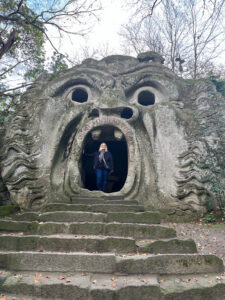 During the pandemic, I was trying to sell a historical novel about a meat carver to a Renaissance cardinal, and it wasn’t selling. I was talking to a friend of mine and lamenting this, and she suggested that gothics are hot. I thought, if I were going to write a gothic, where would I set it? I first thought of this garden I had visited in Italy a couple of years before: the Sacro Bosco, a garden in Bomarzo, Italy, filled with stone monsters. There is a castle on the hill that overlooks this garden. Inside the garden are statues of ancient gods and goddesses, and that was the beginning of my story.
During the pandemic, I was trying to sell a historical novel about a meat carver to a Renaissance cardinal, and it wasn’t selling. I was talking to a friend of mine and lamenting this, and she suggested that gothics are hot. I thought, if I were going to write a gothic, where would I set it? I first thought of this garden I had visited in Italy a couple of years before: the Sacro Bosco, a garden in Bomarzo, Italy, filled with stone monsters. There is a castle on the hill that overlooks this garden. Inside the garden are statues of ancient gods and goddesses, and that was the beginning of my story.
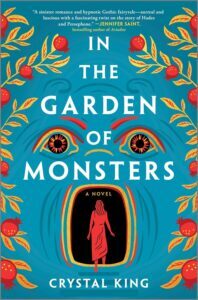 Persephone has been written about so many times, including some popular books about her that are out now. I don’t think I would have written about Persephone if I hadn’t been inspired by the statues in the garden. There is a Mouth of Hell, a statue of Demeter, another of Persephone, and many other mythological gods and creatures. It made sense to explore the story from there. I included Salvador Dalí because he visited the garden in 1948, and the garden is very surrealistic. I thought it would be perfect to include him to play upon some of that strangeness in this story. The Sacro Bosco is a wonderfully unusual place. You can learn more about the garden on my website.
Persephone has been written about so many times, including some popular books about her that are out now. I don’t think I would have written about Persephone if I hadn’t been inspired by the statues in the garden. There is a Mouth of Hell, a statue of Demeter, another of Persephone, and many other mythological gods and creatures. It made sense to explore the story from there. I included Salvador Dalí because he visited the garden in 1948, and the garden is very surrealistic. I thought it would be perfect to include him to play upon some of that strangeness in this story. The Sacro Bosco is a wonderfully unusual place. You can learn more about the garden on my website.
My biggest challenge was getting access to Palazzo Orsini during the pandemic. I could visit the garden, but the Palazzo, where much of the book is set, was closed when visited during the time I was working on the novel. It wasn’t until I was finished that I could finally see the inside. Fortunately, there’s a lot of good information online, including many images and videos I could access.
While it wasn’t a research challenge, I also faced an interesting dilemma about how to include Salvador Dalí because he was a very problematic figure. If he lived today, he’d be canceled in a hot minute. I needed to figure out how to strike a balance between his charismatic and interesting side and his less savory aspects.
Is there a particular photo or piece of art by Salvador Dalí that strikes a chord with you? Why?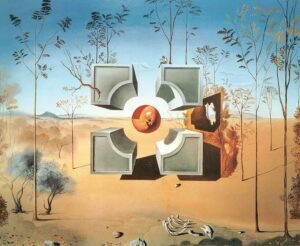 I wasn’t a big fan of Dalí before I began researching him. He has a lot of paintings that are very unattractive in my mind or depict things that I find disgusting and strange. But there are many paintings that are quite beautiful and inspire you to use your imagination. I appreciate the side of him when he is trying less to shock and more to awe. He has a couple of paintings with pomegranates in them, the most famous being ‘Dream Caused by the Flight of a Bee around a Pomegranate a Second before Waking’. But there is also a painting that has come to be very special to me, and it’s one that is very rarely referenced. I discovered it when I was looking to see what he painted in 1948, potentially after he might have visited the garden. While the painting that I’m thinking of, which is untitled, does not include any real elements of the garden, there is a monstrous pomegranate floating in midair with an interesting frame around it against a landscape background. There’s a little tiny man playing a trumpet, and he’s sitting on the top of the frame. I included that man sitting on top of the building in the garden, and that painting features prominently at the end of the book. You can see both of these images on my page about Dalí .
I wasn’t a big fan of Dalí before I began researching him. He has a lot of paintings that are very unattractive in my mind or depict things that I find disgusting and strange. But there are many paintings that are quite beautiful and inspire you to use your imagination. I appreciate the side of him when he is trying less to shock and more to awe. He has a couple of paintings with pomegranates in them, the most famous being ‘Dream Caused by the Flight of a Bee around a Pomegranate a Second before Waking’. But there is also a painting that has come to be very special to me, and it’s one that is very rarely referenced. I discovered it when I was looking to see what he painted in 1948, potentially after he might have visited the garden. While the painting that I’m thinking of, which is untitled, does not include any real elements of the garden, there is a monstrous pomegranate floating in midair with an interesting frame around it against a landscape background. There’s a little tiny man playing a trumpet, and he’s sitting on the top of the frame. I included that man sitting on top of the building in the garden, and that painting features prominently at the end of the book. You can see both of these images on my page about Dalí .
One of my favorite images, though, is one my husband bought for me as a lithograph for a recent milestone birthday. It’s part of a series that he did for Dante’s Inferno, and it’s of Cerberus rearing back in front of Dante.
Your first two books were about culinary figures, and there was a lot of food in their pages. Does this book have any food?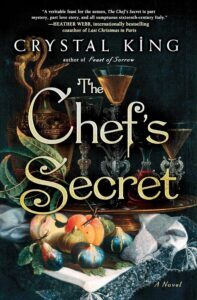 I think this book has more food in it than my previous two combined. Because much of the myth of Persephone centers around her eating pomegranate seeds, that gave me incredible creativity to play with. The book takes place over the course of a week, and every day, the characters partake in incredible feasts. I explore several different Italian eras in the food they eat, and I also highlight some of the recipes that are in the Dalí cookbook that came out much later, in 1978. I tease the idea that Dalí had been thinking of the food long before. Like my previous novels, I have a free companion cookbook for In The Garden of Monsters, which features recreations of the dishes in the novel, made by food book bloggers, chefs, food historians, and me.
I think this book has more food in it than my previous two combined. Because much of the myth of Persephone centers around her eating pomegranate seeds, that gave me incredible creativity to play with. The book takes place over the course of a week, and every day, the characters partake in incredible feasts. I explore several different Italian eras in the food they eat, and I also highlight some of the recipes that are in the Dalí cookbook that came out much later, in 1978. I tease the idea that Dalí had been thinking of the food long before. Like my previous novels, I have a free companion cookbook for In The Garden of Monsters, which features recreations of the dishes in the novel, made by food book bloggers, chefs, food historians, and me.
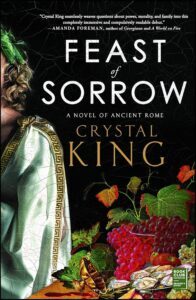 I didn’t expect to fall in love with Italy in the way that I did. I had just finished writing Feast of Sorrow, my first novel, and I thought I probably should visit Rome, considering so much of it is set there. So I went with my husband, who is a third-generation Italian. We fell in love from the moment we stepped foot in the city of Rome. I knew it was somewhere I was meant to be; it was like I had come home. There’s no way to describe that sensation. I don’t know if I believe in past lives or anything like that, but I felt like this was a place where I inherently belonged. Rome is truly where my heart is. I love Italy, I love the people, I love the culture. I just passed the language test to be able to apply for my citizenship, and I’m just passionately in love with the country.
I didn’t expect to fall in love with Italy in the way that I did. I had just finished writing Feast of Sorrow, my first novel, and I thought I probably should visit Rome, considering so much of it is set there. So I went with my husband, who is a third-generation Italian. We fell in love from the moment we stepped foot in the city of Rome. I knew it was somewhere I was meant to be; it was like I had come home. There’s no way to describe that sensation. I don’t know if I believe in past lives or anything like that, but I felt like this was a place where I inherently belonged. Rome is truly where my heart is. I love Italy, I love the people, I love the culture. I just passed the language test to be able to apply for my citizenship, and I’m just passionately in love with the country.
The best advice is the simplest: put your butt in the chair. It’s better if you can do it consistently. I wrote my whole first novel on weekends over the course of three or four years, but now I write every day for an hour. I can tell you that when you do that, there is a very, very big difference in how the stories live in your head. I think you become a more thoughtful writer, a better plotter, and more in tune with your characters when you are consistent about working on your story.
Tell us about your next book.My new novel is not historical fiction, and it doesn’t have any food in it, which doesn’t sound like a Crystal King novel, I realize! But it is still set in Italy, at least partially. It’s a story about some lesser-known nefarious Greek gods that are stealing happiness from the world. You might think of it as a reverse Pandora’s box. More to come on that in the coming months.

Julia Lombardi is a mystery even to herself. The beautiful model can’t remember where she’s from, where she’s been, or how she came to live in Rome. When she receives an offer to accompany celebrated eccentric artist Salvador Dalí to the Sacro Bosco—Italy’s Garden of Monsters—as his muse, she’s strangely compelled to accept. It could be a chance to unlock the truth about her past…
In The Garden of Monsters is a retelling of the myth of Hades and Persephone, inspired by Salvador Dalí’s 1948 visit to the Sacro Bosco Mannerist statue garden.
Thanks so much, Crystal. I also love Rome and Italy. It’s fantastic you are going to become an Italian citizen! And congrats on the release of In the Garden of Monsters. Brava!
You can buy In the Garden of Monsters and Crystal’s backlist here.
 Haven’t subscribed yet to enter into giveaways from my guests? You’re not too late for the chance to win this month’s book if you subscribe to my Inspiration newsletter for giveaways and insights into history – both trivia and the serious stuff! In appreciation for subscribing, I’m offering an 80 page free short story Dying for Rome -Lucretia’s Tale.
Haven’t subscribed yet to enter into giveaways from my guests? You’re not too late for the chance to win this month’s book if you subscribe to my Inspiration newsletter for giveaways and insights into history – both trivia and the serious stuff! In appreciation for subscribing, I’m offering an 80 page free short story Dying for Rome -Lucretia’s Tale.
The post On Inspiration: Interview with Crystal King first appeared on Elisabeth Storrs Historical Novels.
August 17, 2024
Stephanie Dray on Becoming Madam Secretary
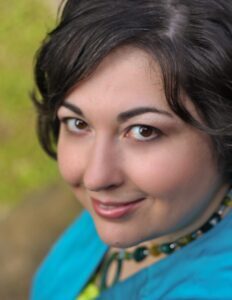 I’m absolutely delighted to feature Stephanie Dray again on Triclinium. She is not only a talented author but a lovely person who is very generous with her time. She is a New York Times, Wall Street Journal & USA Today bestselling author of historical women’s fiction. Her award-winning work has been translated into many languages and tops lists for the most anticipated reads of the year. Now she lives in Maryland with her husband, cats, and history books.
I’m absolutely delighted to feature Stephanie Dray again on Triclinium. She is not only a talented author but a lovely person who is very generous with her time. She is a New York Times, Wall Street Journal & USA Today bestselling author of historical women’s fiction. Her award-winning work has been translated into many languages and tops lists for the most anticipated reads of the year. Now she lives in Maryland with her husband, cats, and history books.
As fellow ancient history buff, I loved Stephanie’s Egyptian novels but she has moved forward in recent years to explore America’s history with America’s First Daughter, My Dear Hamilton, The Women of Chateau Lafayette and now Becoming Madam Secretary.
You can connect with Stephanie via Facebook, Instagram and her Amazon page. She also runs a terrific newsletter with lots of giveaways so be sure to sign up via her website.
Becoming Madam Secretary is a captivating and richly dramatic novel about Frances Perkins, one of the greatest political figures of the twentieth century, and an unsung heroine whose legacy is woven into the fabric of every American life. I was interested to learn more about Frances and how Stephanie came to write the novel.
 Can you tell me how you came across Frances Perkins?
Can you tell me how you came across Frances Perkins?I knew that she was a groundbreaking political figure–our first woman to serve in a presidential cabinet. And I thought someone ought to write about her; I just wasn’t convinced it ought to be me. I had the impression that she was matronly, stern and dull. That is, until I stumbled over a photo of a very young Frances Perkins, who was stylish, dashing, and anything but dull. She used to go undercover to expose pimps and human traffickers, for goodness sake. So I had to know how the intrepid young Fannie Perkins, the daughter of a stationery store owner, rose to White House. And it’s quite a story!
How did you approach researching her story?I started the novel in March of 2020 just as everything was shutting down for the pandemic, so I knew I would have to approach this differently. I couldn’t go anywhere or talk to anybody face to face, so I started out relying heavily on biographies and her transcribed oral history at Columbia University. Eventually I was able to get eyes on her personal papers too, but it didn’t start from that point of view.
What challenges do you face in bringing strong women characters to the fore within the limitations placed on them during the era?I love writing about women who I consider to be Founding Mothers of my country. It’s been clear to me that Jefferson, Hamilton, Lafayette, and the others could never have been what they were without the women behind and beside them. But I’m often reconstructing their lives based on the fragments we find about the men in their lives. There’s little primary source material on the ladies. For me, it was a natural jump to Frances Perkins, who is undoubtedly a Founding Mother of the 20th century, whose work shaped an entire century. But what was different about her from the start is that there was an enormous public record I could use. She was in the newspapers constantly. And she had far more agency than most of the ladies I’d written about before. I knew she would have found a way to be consequential with or without Franklin Delano Roosevelt. In fact, he wasn’t even her first political partner. So even though she was in FDR’s orbit, he was also in hers and that made the difference to his whole presidency.
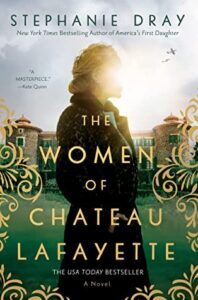 What was the most surprising thing you learned about Frances?
What was the most surprising thing you learned about Frances?That she had a great and playful sense of humor. People talk about her as an unfailingly serious person of boundless wisdom and philosophical depth. She certainly was that. But her own oral history proves that she was also funny and she enjoyed being around party girls like Mary Rumsey and cut ups like Sinclair Lewis. I feel like women are always expected to fit into one box. The madonna or the whore. The brainiac or the bimbo. And so on. I think Frances wanted us to put her in the box of serious cabinet secretary, because she thought that’s what she had to be to represent other women well, to represent the country well, and to fulfil her mission as she saw it. But Frances wasn’t only ever one thing. None of us ever is.
Did you form a different view about Franklin D Roosevelt after learning about Frances’ interaction with him?Yes!! I still think FDR is one of the greatest and most consequential presidents in the country’s history. I put him up there in the top tier with Washington and Lincoln. But oh, he could be such a jerk. Such a completely opportunistic political animal. Such a coward at times. LOL. Again, I guess that just goes to show you that people–especially leaders–are very complicated.
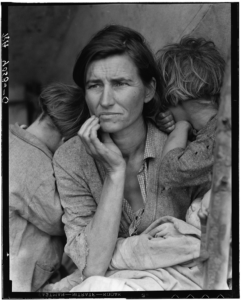 Do you have a particular favourite image or artwork associated with the period in which your book is set? Why?
Do you have a particular favourite image or artwork associated with the period in which your book is set? Why?Dorothea Lange’s iconic image from the Great Depression “The Migrant Mother” is emblazoned on my brain. It effectively conveys the kind of struggle and desperate trouble the country was in when Frances Perkins was called to serve.
Is there anything unusual or even quirky that you would like to share about your writing of Becoming Madam Secretary?I don’t know if this is exactly quirky or unusual, but it is meaningful to me, so I will say that four of my grandparents lived through the Great Depression and they all had stories. One of the most tragic was that my grandfather’s teenaged older brother decided, in desperation, to steal coal from a passing train to keep the family warm during a very cold Rochesterian winter. He died in that attempt and the family never got over that loss. My grandfather would go on to join the Civilian Conservation Corps when he was old enough and he was very proud of the lumberjacking skills he learned serving the country, and of his ability to send home some money to keep the family afloat. So I was very moved to learn just how involved Frances Perkins was in that program. I’m not sure my family would have survived without her and then I wouldn’t be here to tell the tale!
Tell us about your next book.Thanks for asking! I’m now working on a novel with my good friend and sometime co-author Laura Kamoie about a little-known Founding Mother named Abigail Adams!

Raised on tales of her revolutionary ancestors, Frances Perkins arrives in New York City at the turn of the century, armed with her trusty parasol and an unyielding determination to make a difference.When she’s not working with children in the crowded tenements in Hell’s Kitchen, Frances throws herself into the social scene in Greenwich Village, befriending an eclectic group of politicians, artists, and activists, including the millionaire socialite Mary Harriman Rumsey, the flirtatious budding author Sinclair Lewis, and the brilliant but troubled reformer Paul Wilson, with whom she falls deeply in love.
But when Frances meets a young lawyer named Franklin Delano Roosevelt at a tea dance, sparks fly in all the wrong directions. She thinks he’s a rich, arrogant dilettante who gets by on a handsome face and a famous name. He thinks she’s a priggish bluestocking and insufferable do-gooder. Neither knows it yet, but over the next twenty years, they will form a historic partnership that will carry them both to the White House.
Frances is destined to rise in a political world dominated by men, facing down the Great Depression as FDR’s most trusted lieutenant—even as she struggles to balance the demands of a public career with marriage and motherhood. And when vicious political attacks mount and personal tragedies threaten to derail her ambitions, she must decide what she’s willing to do—and what she’s willing to sacrifice—to save a nation.

Thanks so much for taking the time to tell us about Frances Perkins. As an Australian, I always find it fascinating to learn about pockets of American history that is not familiar to me. You can buy Becoming Madam Secretary and all Stephanie’s back list here.
 Haven’t subscribed yet to enter into giveaways from my guests? You’re not too late for the chance to win this month’s book if you subscribe to my Inspiration newsletter for giveaways and insights into history – both trivia and the serious stuff! In appreciation for subscribing, I’m offering an 80 page free short story Dying for Rome -Lucretia’s Tale.
Haven’t subscribed yet to enter into giveaways from my guests? You’re not too late for the chance to win this month’s book if you subscribe to my Inspiration newsletter for giveaways and insights into history – both trivia and the serious stuff! In appreciation for subscribing, I’m offering an 80 page free short story Dying for Rome -Lucretia’s Tale.
The post Stephanie Dray on Becoming Madam Secretary first appeared on Elisabeth Storrs Historical Novels.



